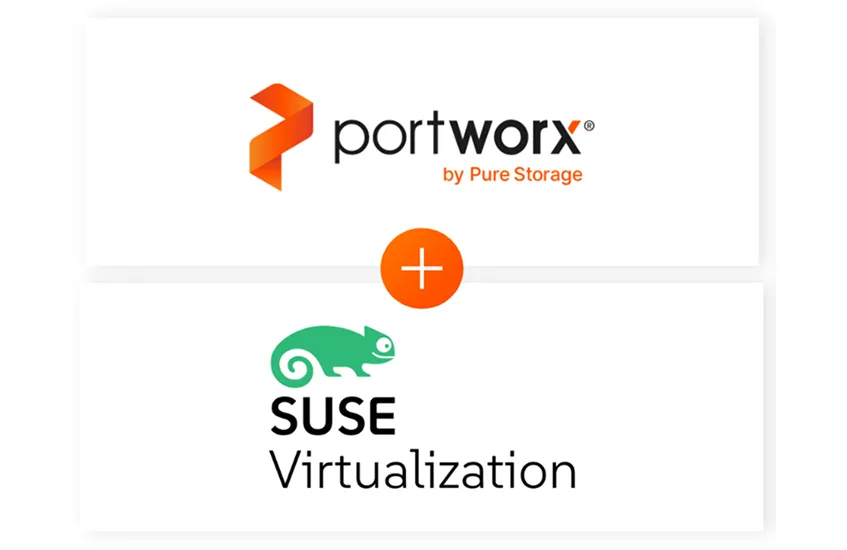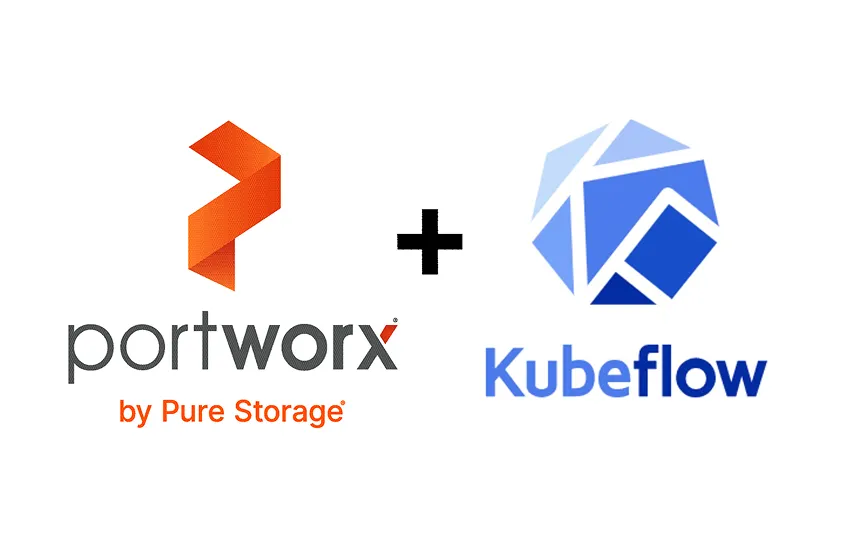How to run a multi-tenant WordPress platform on Azure Kubernetes Service
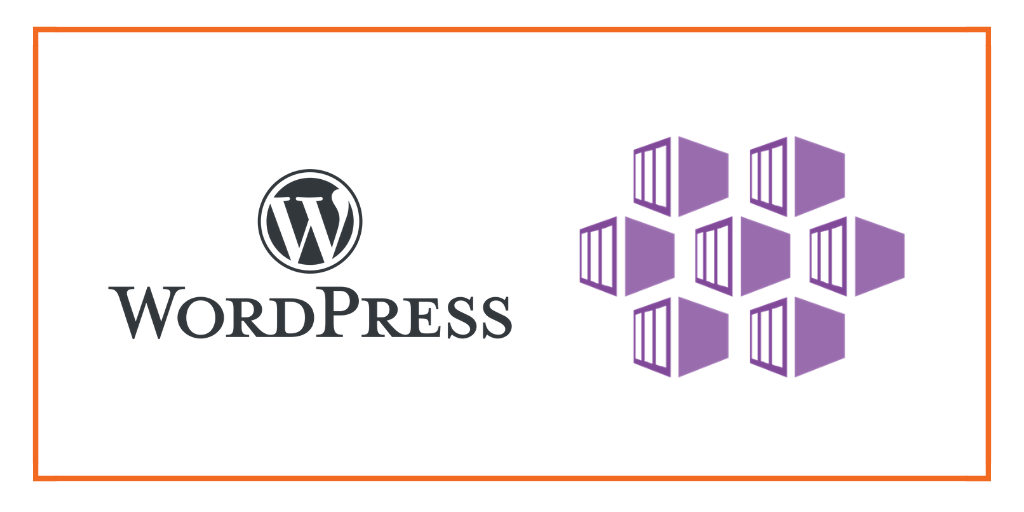
This post is part of our ongoing series on running WordPress on Kubernetes. We’ve published a number of articles about running WordPress on Kubernetes for specific platforms and for specific use cases. If you are looking for a specific Kubernetes platform, check out these related articles.
Running HA WordPress on Amazon Elastic Container Service for Kubernetes (EKS)
Running HA WordPress on Google Kubernetes Engine (GKE)
Running HA WordPress on Red Hat OpenShift
Running HA WordPress on IBM Cloud Kubernetes Service (IKS)
Running HA WordPress with Rancher Kubernetes Engine (RKE)
Running HA WordPress on IBM Cloud Private
And now, onto the post…
In the world of Kubernetes demos, WordPress is one of the canonical examples, but usually, the complexity of WordPress itself is just an afterthought. WordPress is just the container that we deploy to demonstrate some other capability, not a multifaceted application that needs to be deployed, scaled, backed up, and managed. For all the countless examples, rarely do they talk about what it means to run a multi-tenant WordPress environment from the perspective of a service provider selling WordPress sites for profit. The reason? Running a multi-tenant WordPress environment on Kubernetes is actually quite hard and these examples are designed to show simple things. So the complexity is swept under the rug.
Today we discuss some of the hard problems you need to solve in order to run a multi-tenant WordPress deployment as a service provider. Portworx has a lot of experience helping hosting companies and other service providers run lots of WordPress sites for paying customers. This blog is a summary of that work.
In these multi-tenant WordPress deployments, there are a few important capabilities that customers must achieve.
- It is important to host as many independent, isolated WordPress sites on the same host in order to maximize resource utilization and keep costs low. This means that often we need to have 100s of sites on a single server.
- If a WordPress site is consuming too many resources and harming the performance of other sites (i.e., the noisy neighbor problem), it must be easy to relocate that site to another host (or to move less resource intensive sites away, leaving fewer sites on the host).
- It must be possible to independently backup a single WordPress site even if it is running on a host with dozens or hundreds of other sites.
- It must be possible to limit resource consumption at the site level and upsell additional resources to the end-customer. For example, if they need more storage, we should be able to “turn on” that feature easily.
Why Portworx is perfect for large scale multi-tenant WordPress deployments
Portworx wasn’t designed with only WordPress in mind, but you might think that it was. First, Portworx supports persistent storage and data management for two critical WordPress components:
- A highly available single-writer MySQL database that typically scales vertically
- Fast “read-write-many (RWX)” or “multi-writer” or “shared” volumes for file uploads needed as the WordPress PHP container is scaled horizontally.
Without a solution for both MySQL and NFS-like file storage, a persistent storage solution for Kubernetes cannot claim to be able to handle WordPress workloads. But just persistent storage isn’t enough either.
As a service provider running WordPress sites, it is all about density, density, density
WordPress is said to run 28% of all websites on the Internet. That is a phenomenal install base of roughly 75 million sites. While some of these are massive sites like TechCrunch or The New Yorker, the vast majority of WordPress sites are much smaller. That means as a WordPress hoster, your business probably follows the 80-20 rule. 80% of your revenue comes from 20% of your sites. Or said another way, 80% of your sites only account for 20% of your traffic.
That means that you need to think about your business in two ways:
- You need to provide a reliable service to a large number of low-traffic sites while minimizing infrastructure costs since your margins come in large part from placing more sites on the same physical infrastructure.
- You need to provide a white-glove, highly performant and reliable experience to a small number of sites that make up the bulk of your revenue.
At the same time, you need a migration path for some sites to move from low-volume to high-volume plan, without disrupting the customer or your own internal operations teams.
Let’s look at how Portworx solves these requirements in turn.
How to achieve 100s of WordPress sites per host
As we have seen, each WordPress site requires 2 persistent volumes. One for MySQL, one for shared storage. A Linux host, however, is limited to 40 volumes maximum when using a solution like Amazon EBS or a traditional SAN. That means that unless you use the same volume for multiple sites, you are limited to 20 sites per host, no matter how large the host is. This is often the choice that WordPress hosters make, but what they gain in density, they lose in isolation. Since multiple sites share the same volumes, you cannot backup and restore only a single site as easily.
With Portworx however, a single block device provided by Amazon, Google, Azure, your existing SAN or even the bare metal server can be divided up in hundreds of virtual volumes, allowing hundreds of sites to run on the same host. Here is how one Portworx customer, Aurea, was able to leverage Portworx for running hundreds of apps on the same host:
“Our clusters are highly dense, meaning we run a lot of containers per host. On AWS, we use huge instances. The recommendation from Kubernetes is 100 pods per VM. Already, we’re running 200-300 pods per host. Also, since most of the apps that we run are stateful, we can easily have 200-300 volumes per host as well. And we’re working to push these limits even further. Because of these densities enabled by Kubernetes and Portworx, we’re easily saving 60-90% on our compute costs. Portworx itself was between 30-50% cheaper than any other storage solution we tested.”
Dealing with the noisy neighbor problem
We’ve just seen how Portworx can help service providers increase the density of their WordPress deployments while simplifying operations. Now let’s look at how hosters can solve one of the biggest problems in multi-tenant environments: noisy neighbors.
If you categorically knew which 20% of your customers would account for 80% of your traffic at all times, solving the noisy neighbor problem would be a one-time migration. But, because traffic patterns change over time, this is a hard problem to solve. Portworx does a few critical things to help.
First, in addition to using Kubernetes to limit pod resources like Memory and CPU, you can use Portworx to automatically place different workloads on different storage hardware for different classes of service. For instance, you might sell your customers a premium “performance” plan if they are expecting heavy usage and they are performance sensitive. Alternatively, cost-conscious customers might opt for a “budget” plan that offers reliability but doesn’t guarantee blazing fast performance. On the backend, these plans can be mapped to Portworx “storage classes” that automatically place high-end plans on SSDs and low-end plans on HHDs.
Additionally, since you don’t always know when one a customer site will suddenly experience a spike in traffic draining resources from neighbor sites, Portworx enables you to move applications between environments using PX-Motion. With PX-Motion you can move a single pod or group of pods to a different Kubernetes environment with a single command.
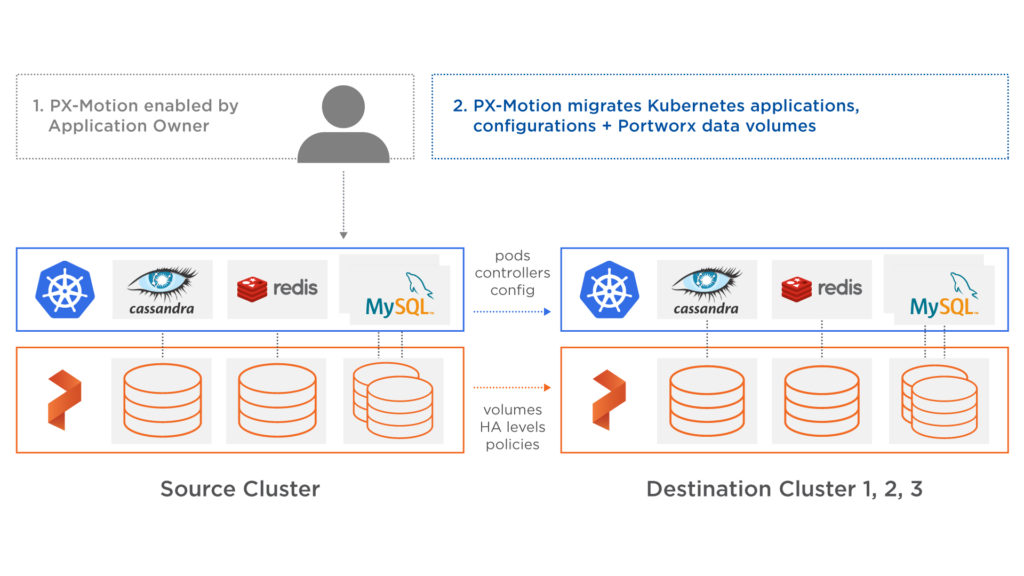
Often a hosting customer will call their service provider the day before they are going to be on national TV and say “I really need my site to work tomorrow.” This often leads to a lot of scrambling around and manual tuning, but with PX-Motion, moving the customer to an environment with more resources is as easy as kubectl apply -f wp-migration.yaml.
The above process describes moving one heavy load site off a multi-tenant cluster. This is often the best option if you have some advance warning before a large traffic spike. However, in the middle of a large traffic event, it is often better to move low traffic sites away from the heavy traffic site to free up resources, instead of vice versa. This is also possible with PX-Motion.
“Oops, I deleted all my blogs. Can you help?”
Every WordPress hoster has heard this before. Accidents happen and when they do, your customer calls you… desperate. The problem for large multi-tenant environments is that true site-based isolation is difficult, especially if you have gone past the 20-sites per host limit described above by pooling storage for multiple sites into the same volume.
With Portworx, these limitations don’t apply. Each WordPress site gets its own MySQL and shared volumes, which can be fully and independently controlled, managed, snapshotted, backed up and migrated. For example, you can easily set up a backup policy that snapshots a single WordPress environment (MySQL and files) every hour and back it up to an object store. Then, if you get that frantic phone call from a customer, you can easily restore just their site, without affecting anyone else. Importantly, using Portworx 3DSnap, these snapshots of MySQL and WordPress files are application consistent, not just crash consistent, ensuring easy recover from backup.
Let’s see that is action
Now that we’ve looked at a high level at how Portworx helps service providers run large scale multi-tenant WordPress environment, let’s go a step deeper and look at how it works on Kubernetes. This post looks at how to run an HA WordPress on Azure Kubernetes Service (AKS), a managed Kubernetes offering from Microsoft, which makes it easy to create, configure, and manage a cluster of virtual machines that are preconfigured to run containerized applications. We have other blogs about how to run a similar setup on Amazon EKS and Google GKE.
In summary, to run HA WordPress on Azure you need to:
- Create an AKS cluster
- Install cloud native storage solution like Portworx as a daemon set on AKS
- Create a storage class defining your storage requirements like replication factor, snapshot policy, and performance profile
- Deploy MySQL using Kubernetes
- Deploy and scale WordPress using Kubernetes
How to set up an AKS cluster
Portworx is fully supported on Azure Kubernetes Service. Run the following commands to configure a 3 node cluster in Europe West. More on Azure AKS is available here.
$ az group create --name px --location westeurope $ az aks install-cli $ az aks create --resource-group px --name pxdemo --node-count 3 --generate-ssh-keys $ az aks get-credentials --resource-group px --name pxdemo
When the cluster is ready, verify it with the following command:
$ kubectl get nodes NAME STATUS ROLES AGE VERSION aks-nodepool1-12748671-0 Ready agent 89m v1.9.11 aks-nodepool1-12748671-1 Ready agent 89m v1.9.11 aks-nodepool1-12748671-2 Ready agent 89m v1.9.11

Provision Azure Storage Nodes
Running storage nodes separately from compute nodes will allow us to independently scale compute and storage resources. We use Portworx to manage the storage nodes and also access storage from the compute nodes.
Follow these steps to create three storage node VMs. Afterward, we attach the Managed Disk to the storage nodes in the Azure portal using these instructions. Finally, we ssh into the VM and install Portworx on each of the storage nodes using the commands below.
latest_stable=$(curl -fsSL 'https://install.portworx.com/1.4/?type=dock&stork=false' | awk '/image: / {print $2}')
# Download OCI bits (reminder, you will still need to run `px-runc install ..` after this step)
sudo docker run --entrypoint /runc-entry-point.sh \
--rm -i --privileged=true \
-v /opt/pwx:/opt/pwx -v /etc/pwx:/etc/pwx \
$latest_stable
# Basic installation where
sudo /opt/pwx/bin/px-runc install -c CLUSTER-NAME \
-k etcd://[etcd-service]:2379 \
-a -f
# Reload systemd configurations, enable and start Portworx service
sudo systemctl daemon-reload
sudo systemctl enable portworx
sudo systemctl start portworx
For the CLUSTER-NAME, use the same string in each of your installs for that cluster.
Installing Portworx in AKS
Installing Portworx on Azure Kubernetes Service is not very different from installing it on a Kubernetes cluster setup through Kops. Portworx AKS documentation has the steps involved in running the Portworx cluster in a Kubernetes environment deployed in Azure.
Portworx cluster needs to be up and running on AKS before proceeding to the next step. The kube-system namespace should have the Portworx pods in Running state.
$ kubectl get pods -n=kube-system -l name=portworx NAME READY STATUS RESTARTS AGE portworx-9b4xz 1/1 Running 0 82m portworx-fllww 1/1 Running 0 82m portworx-m2qn7 1/1 Running 0 82m

Creating a storage class for MySQL
Once the AKS cluster is up and running, and Portworx is installed and configured, we will deploy a highly available MySQL database.
Through storage class objects, an admin can define different classes of Portworx volumes that are offered in a cluster. These classes will be used during the dynamic provisioning of volumes. The Storage Class defines the replication factor, I/O profile (e.g., for a database or a CMS), and priority (e.g., SSD or HDD). These parameters impact the availability and throughput of workloads and can be specified for each volume. This is important because a production database will have different requirements than a development Jenkins cluster.
In this example, the storage class that we deploy has a replication factor of 3 with I/O profile set to “db_remote” and priority set to “high.” This means that the storage will be optimized for low latency database workloads like MySQL and automatically placed on the highest performance storage available in the cluster. Notice that we also mention the filesystem, xfs in the storage class.
$ cat > px-mysql-sc.yaml << EOF
kind: StorageClass
apiVersion: storage.k8s.io/v1beta1
metadata:
name: px-ha-sc
provisioner: kubernetes.io/portworx-volume
parameters:
repl: "3"
io_profile: "db_remote"
priority_io: "high"
fs: "xfs"
EOF
$ kubectl create -f px-mysql-sc.yaml storageclass.storage.k8s.io "px-ha-sc" created $ kubectl get sc NAME PROVISIONER AGE $ kubectl get sc NAME PROVISIONER AGE default (default) kubernetes.io/azure-disk 3h47m managed-premium kubernetes.io/azure-disk 3h47m px-ha-sc kubernetes.io/portworx-volume 4s stork-snapshot-sc stork-snapshot 3h34m
Creating a MySQL PVC on Kubernetes
We can now create a Persistent Volume Claim (PVC) based on the Storage Class. Thanks to dynamic provisioning, the claims will be created without explicitly provisioning a Persistent Volume (PV).
$ cat > px-mysql-pvc.yaml << EOF
kind: PersistentVolumeClaim
apiVersion: v1
metadata:
name: px-mysql-pvc
annotations:
volume.beta.kubernetes.io/storage-class: px-ha-sc
spec:
accessModes:
- ReadWriteOnce
resources:
requests:
storage: 1Gi
EOF
$ kubectl create -f px-mysql-pvc.yaml
persistentvolumeclaim "px-mysql-pvc" created
$ kubectl get pvc
NAME STATUS VOLUME CAPACITY ACCESS MODES STORAGECLASS AGE
px-mysql-pvc Bound pvc-35a9f85a-ea1f-11e8-aee2-3eb8d1b34ba8 1Gi RWO px-ha-sc 13s
Deploying MySQL on AKS
Finally, let’s create a MySQL instance as a Kubernetes deployment object. For simplicity’s sake, we will just be deploying a single MySQL pod. This is often sufficient for multi-tenant WordPress environments because each site is small and because Portworx provides synchronous replication for High Availability, a single MySQL instance might be the best deployment option for your MySQL database. Portworx can also provide backing volumes for multi-node MySQL clusters for your larger customers. The choice is yours.
$ cat > px-mysql-app.yaml << EOF
apiVersion: apps/v1
kind: Deployment
metadata:
name: mysql
spec:
strategy:
rollingUpdate:
maxSurge: 1
maxUnavailable: 1
type: RollingUpdate
replicas: 1
selector:
matchLabels:
app: mysql
template:
metadata:
labels:
app: mysql
spec:
schedulerName: stork
containers:
- name: mysql
image: mysql:5.6
imagePullPolicy: "Always"
env:
- name: MYSQL_ROOT_PASSWORD
value: password
ports:
- containerPort: 3306
volumeMounts:
- mountPath: /var/lib/mysql
name: mysql-data
volumes:
- name: mysql-data
persistentVolumeClaim:
claimName: px-mysql-pvc
EOF
$ kubectl create -f px-mysql-app.yaml deployment.extensions "mysql" created
The MySQL deployment defined above is explicitly associated with the PVC, px-mysql-pvc created in the previous step.
This deployment creates a single pod running MySQL backed by Portworx.
$ kubectl get pods NAME READY STATUS RESTARTS AGE mysql-654cc68f68-xzhln 1/1 Running 0 25s
We can inspect the Portworx volume by accessing the pxctl tool running with the MySQL pod.
$ VOL=`kubectl get pvc | grep px-mysql-pvc | awk '{print $3}'`
$ PX_POD=$(kubectl get pods -l name=portworx -n kube-system -o jsonpath='{.items[0].metadata.name}')
$ kubectl exec -it $PX_POD -n kube-system -- /opt/pwx/bin/pxctl volume inspect ${VOL}
Volume : 297361477631896823
Name : pvc-35a9f85a-ea1f-11e8-aee2-3eb8d1b34ba8
Size : 1.0 GiB
Format : xfs
HA : 3
IO Priority : LOW
Creation time : Nov 17 04:14:00 UTC 2018
Shared : no
Status : up
State : Attached: aks-nodepool1-12748671-1 (10.240.0.6)
Device Path : /dev/pxd/pxd297361477631896823
Labels : pvc=px-mysql-pvc
Reads : 80
Reads MS : 24
Bytes Read : 380928
Writes : 470
Writes MS : 30272
Bytes Written : 166633472
IOs in progress : 0
Bytes used : 121 MiB
Replica sets on nodes:
Set 0
Node : 10.240.0.6 (Pool 0)
Node : 10.240.0.4 (Pool 0)
Node : 10.240.0.5 (Pool 0)
Replication Status : Up
Volume consumers :
- Name : mysql-654cc68f68-xzhln (523275ef-ea1f-11e8-aee2-3eb8d1b34ba8) (Pod)
Namespace : default
Running on : aks-nodepool1-12748671-1
Controlled by : mysql-654cc68f68 (ReplicaSet)
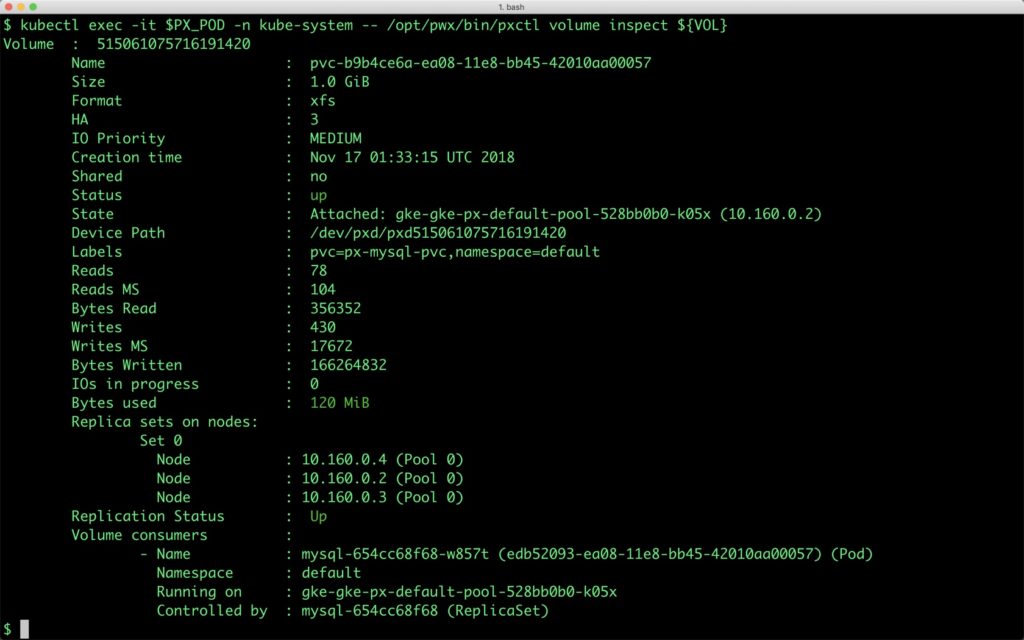
The output from the above command confirms the creation of volumes that are backing the MySQL database instance.
Exposing MySQL as a Headless Service
To enable WordPress deployment to talk to the MySQL deployment, we need to expose it as a Kubernetes service. Since it is an internal service accessed by name, we will create a headless service that doesn’t assign an IP address. Refer to Kubernetes documentation for more details on the headless service.
The YAML file below has the definition of the MySQL headless service.
$ cat > px-mysql-svc.yaml << EOF
apiVersion: v1
kind: Service
metadata:
name: mysql
labels:
app: mysql
spec:
ports:
- port: 3306
name: mysql
clusterIP: None
selector:
app: mysql
EOF
$ kubectl create -f px-mysql-svc.yaml service/mysql created
Verify the creation of the service by describing it. Note that the ClusterIP doesn’t have an IP address assigned. The service points to a single MySQL pod that was created earlier.
$ kubectl describe svc mysql Name: mysql Namespace: default Labels: app=mysql Annotations: Selector: app=mysql Type: ClusterIP IP: None Port: mysql 3306/TCP TargetPort: 3306/TCP Endpoints: 10.244.1.6:3306 Session Affinity: None Events:

Create a shared storage class for WordPress
Unlike other workloads, the pods running WordPress share the storage backend. This enables different instances of WordPress deployed as pods access the same filesystem.
Portworx has a concept of shared volumes or RWX volumes in which multiple pods can share a common storage volume. A shared volume is declared as a part of the storage class.
Additionally, we will specify an io_profile of “cms.” This is useful for content management systems like WordPress and speeds up site performance by implementing an attribute cache.
Let’s define a separate storage class for WordPress with a shared volume.
$ cat > px-shared-sc.yaml << EOF
kind: StorageClass
apiVersion: storage.k8s.io/v1beta1
metadata:
name: px-shared-sc
provisioner: kubernetes.io/portworx-volume
parameters:
repl: "3"
io_profile: "cms"
shared: "true"
EOF
$ kubectl create -f px-shared-sc.yaml
storageclass.storage.k8s.io "px-shared-sc" created
Creating a Shared PVC for WordPress
We will now create a shared Persistent Volume Claim (PVC) based on the Storage Class that we defined earlier for WordPress. This PVC will be used by all the WordPress pods to store the shared content such as HTML, CSS, JPG etc.
$ cat > px-wp-pvc.yaml << EOF
kind: PersistentVolumeClaim
apiVersion: v1
metadata:
name: px-wp-pvc
annotations:
volume.beta.kubernetes.io/storage-class: px-shared-sc
spec:
accessModes:
- ReadWriteMany
resources:
requests:
storage: 1Gi
EOF
$ kubectl create -f px-wp-pvc.yaml
persistentvolumeclaim/px-wp-pvc created
We will now have two PVCs associated with MySQL and WordPress deployments.
$ kubectl get pvc NAME STATUS VOLUME CAPACITY ACCESS MODES STORAGECLASS AGE px-mysql-pvc Bound pvc-35a9f85a-ea1f-11e8-aee2-3eb8d1b34ba8 1Gi RWO px-ha-sc 5m46s px-wp-pvc Bound pvc-001a9ebe-ea20-11e8-aee2-3eb8d1b34ba8 1Gi RWO px-shared-sc 7s
Deploying WordPress on AKS
We are now ready to deploy a WordPress instance that talks to MySQL. Create the following YAML file and submit it to Kubernetes through kubectl.
$ cat > px-wp-app.yaml << EOF
apiVersion: apps/v1
kind: Deployment
metadata:
name: wordpress
labels:
app: wordpress
spec:
strategy:
rollingUpdate:
maxSurge: 1
maxUnavailable: 1
type: RollingUpdate
replicas: 1
selector:
matchLabels:
app: wordpress
template:
metadata:
labels:
app: wordpress
spec:
containers:
- image: wordpress:latest
name: wordpress
env:
- name: WORDPRESS_DB_HOST
value: mysql
- name: WORDPRESS_DB_PASSWORD
value: password
ports:
- containerPort: 80
name: wordpress
volumeMounts:
- name: wp-data
mountPath: /var/www/html
volumes:
- name: wp-data
persistentVolumeClaim:
claimName: px-wp-pvc
EOF
$ kubectl create -f px-wp-app.yaml
deployment.extensions/wordpress created
Let’s verify that both MySQL and WordPress pods are up and running.
$ kubectl get pods NAME READY STATUS RESTARTS AGE mysql-654cc68f68-xzhln 1/1 Running 0 5m39s wordpress-79bcf7bb5f-ssztn 1/1 Running 0 11s
Before accessing the web UI of WordPress, let’s make sure that the Apache server hosting WordPress is running. We can do that by checking the logs of the WordPress pod.
$ kubectl logs wordpress-79bcf7bb5f-ssztn WordPress not found in /var/www/html - copying now... Complete! WordPress has been successfully copied to /var/www/html AH00558: apache2: Could not reliably determine the server's fully qualified domain name, using 192.168.151.67. Set the 'ServerName' directive globally to suppress this message AH00558: apache2: Could not reliably determine the server's fully qualified domain name, using 192.168.151.67. Set the 'ServerName' directive globally to suppress this message [Fri Nov 16 23:35:24.830311 2018] [mpm_prefork:notice] [pid 1] AH00163: Apache/2.4.25 (Debian) PHP/7.2.12 configured -- resuming normal operations [Fri Nov 16 23:35:24.830357 2018] [core:notice] [pid 1] AH00094: Command line: 'apache2 -D FOREGROUND'
Exposing WordPress to the public
In order to access the WordPress UI from the public Internet, we need to expose the deployment through a Kubernetes load balancer service. On AKS, the service will automatically create a load balancer and shows the public IP address associated with it.
Let’s create the load balancer service to expose WordPress.
$ cat > px-wp-svc.yaml << EOF
apiVersion: v1
kind: Service
metadata:
name: wordpress
labels:
app: wordpress
spec:
ports:
- port: 80
selector:
app: wordpress
type: LoadBalancer
EOF
$ kubectl create -f px-wp-svc.yaml
service/wordpress created
We can check the status of the service with the following command:
$ kubectl get svc NAME TYPE CLUSTER-IP EXTERNAL-IP PORT(S) AGE kubernetes ClusterIP 10.0.0.1 443/TCP 3h58m mysql ClusterIP None 3306/TCP 5m52s wordpress LoadBalancer 10.0.175.224 13.73.142.145 80:30366/TCP 2m
AKS has initiated the creation of the load balancer that points to the WordPress service. After a few minutes, you can access the WordPress web UI through the load balancer’s public IP address from any browser.
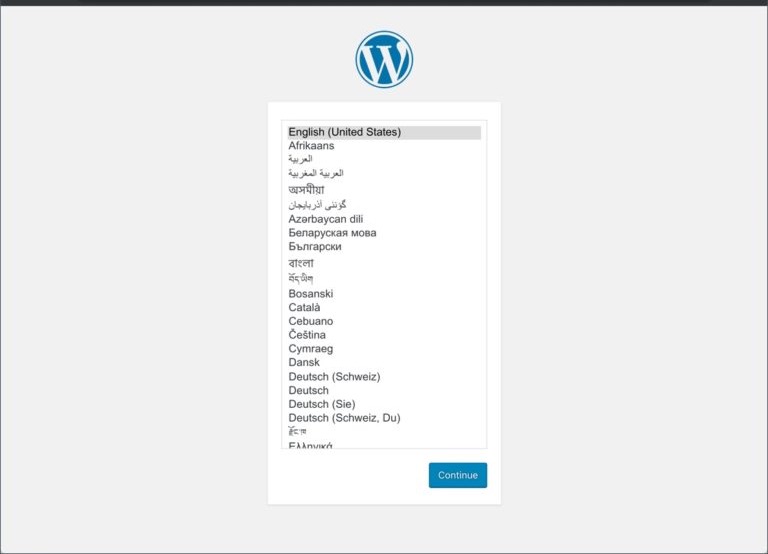
You can scale WordPress by adding more replicas to the deployment. Since all the WordPress pods share the common storage backend based on the Portworx shared volume, the deployment can be easily scaled out.
The MySQL deployment is configured to be in HA mode. For details on how to perform failover, dynamic expansion of the volumes, and/or configuring snapshots, refer to the tutorial on running HA MySQL on AKS.
Summary
Portworx can easily be deployed on Azure Kubernetes Service to run stateful workloads in production. It is an ideal storage platform for transactional databases such as MySQL and read-intensive applications such as WordPress.
Through the integration of STORK, DevOps and StorageOps teams can seamlessly run highly-available workloads in AKS. They can perform traditional operations such as volume expansion, snapshots, and backup and recovery for cloud native applications.
Share
Subscribe for Updates
About Us
Portworx is the leader in cloud native storage for containers.
Thanks for subscribing!

Janakiram MSV
Contributor | Certified Kubernetes Administrator (CKA) and Developer (CKAD)Explore Related Content:
- aks
- databases
- kubernetes
- wordpress


